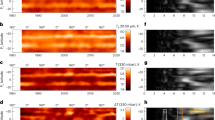Abstract
IN a previous investigation1 atmospheric densities had been derived from the orbital elements2 of the satellites 1958 β 2, 1958 α, 1958 δ and others, and reduced to the mean altitude of the perigee by means of the Kallmann–Juncosa3 model. A good correlation exists between atmospheric fluctuations and the 20-cm. solar flux curve4. This is apparent not only from the ‘monthly’ fluctuations5 but also from long-period variations extending over several months. For altitudes of 660, 350 and 210 km. the relation between density and solar flux is approximately linear for values of solar flux S between 100 and 240 × 10−22 W./m.2 c./s. To demonstrate the effect it was necessary to separate quantitatively the suspected diurnal fluctuations and the fluctuations caused by variable solar radiation. A preliminary investigation was carried out using the geocentric angular distance perigee–Sun which had already been employed by Jacchia (see ref. 2) for comparison with the satellite data. The angular distance proved very useful so long as no separation of the diurnal and terrestrial effects was possible. One expected, however, the atmospheric density to be dependent on Δα = απ−α⊙, Δδ = δπ−δ⊙ and the geocentric latitude ψ of the perigee (where α is right ascension, δ is declination, π is perigee, ⊙ is Sun).
This is a preview of subscription content, access via your institution
Access options
Subscribe to this journal
Receive 51 print issues and online access
$199.00 per year
only $3.90 per issue
Buy this article
- Purchase on Springer Link
- Instant access to full article PDF
Prices may be subject to local taxes which are calculated during checkout
Similar content being viewed by others
References
Priester, W., and Martin, H. A., Mitt. Sternwarte Bonn, 29 Forschungsber. NRW (Westdeutscher Verlag, Köln-Opladen) (in the press).
Jacchia, L. G., Smith. Astrophys. Obs. Spec. Rep. 29 (1959). Space Track Control Center, Bull. Orbital Elements 1958, 1959, Smith. Astrophys. Obs., Bull. Orbital Elements 1958, 1959, Paetzold, H. K., Planet. Space Sci., 1, 115 (1959).
Kallmann, H. K., and Juncosa, M. L., Rand Report Oct. 30 (1958).
Heinrich–Hertz–Institut, Berlin–Aldershof, Beobachtungen 1957–59.
Jacchia, L. G., Harvard Obs. Announcement Card 1423 (1959). Priester, W., Mitt. Sternwarte Bonn 24; Naturwiss., 46, 197 (1959).
Wyatt, S. P., Nature, 184, 351 (1959).
Author information
Authors and Affiliations
Rights and permissions
About this article
Cite this article
MARTIN, H., PRIESTER, W. Measurement of Solar and Diurnal Effects in the High Atmosphere by Artificial Satellites. Nature 185, 600–601 (1960). https://doi.org/10.1038/185600a0
Issue Date:
DOI: https://doi.org/10.1038/185600a0
This article is cited by
-
Wolfgang Priester: from the big bounce to the $\Lambda$-dominated universe
Naturwissenschaften (2007)
-
A review of satellite lifetime and orbit decay prediction
Proceedings of the Indian Academy of Sciences Section C: Engineering Sciences (1982)
-
Zur Vorgeschichte der Weltraumforschung
Die Naturwissenschaften (1962)
-
Density of the Upper Atmosphere and its Dependence on the Sun, as Revealed by Satellite Orbits
Nature (1960)
-
Variation of Upper-Atmosphere Density with Latitude and Season: Further Evidence from Satellite Orbits
Nature (1960)
Comments
By submitting a comment you agree to abide by our Terms and Community Guidelines. If you find something abusive or that does not comply with our terms or guidelines please flag it as inappropriate.



